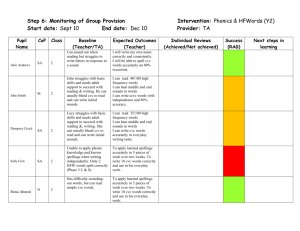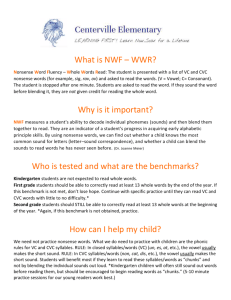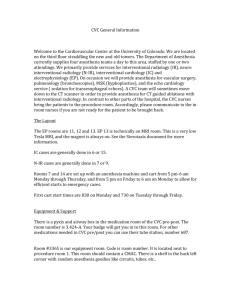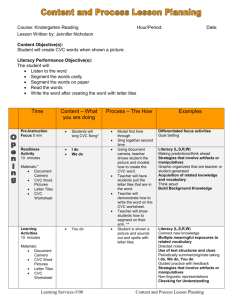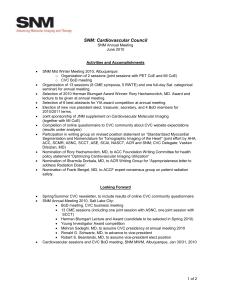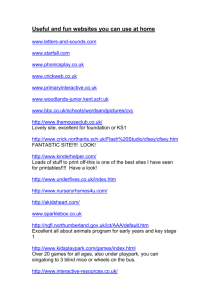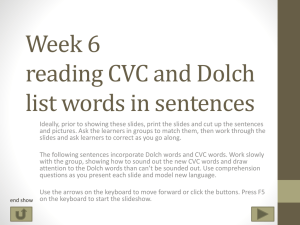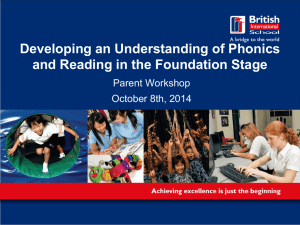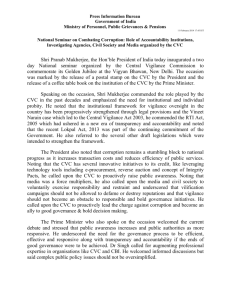CVC Words Lesson Plan for Kindergarten
advertisement
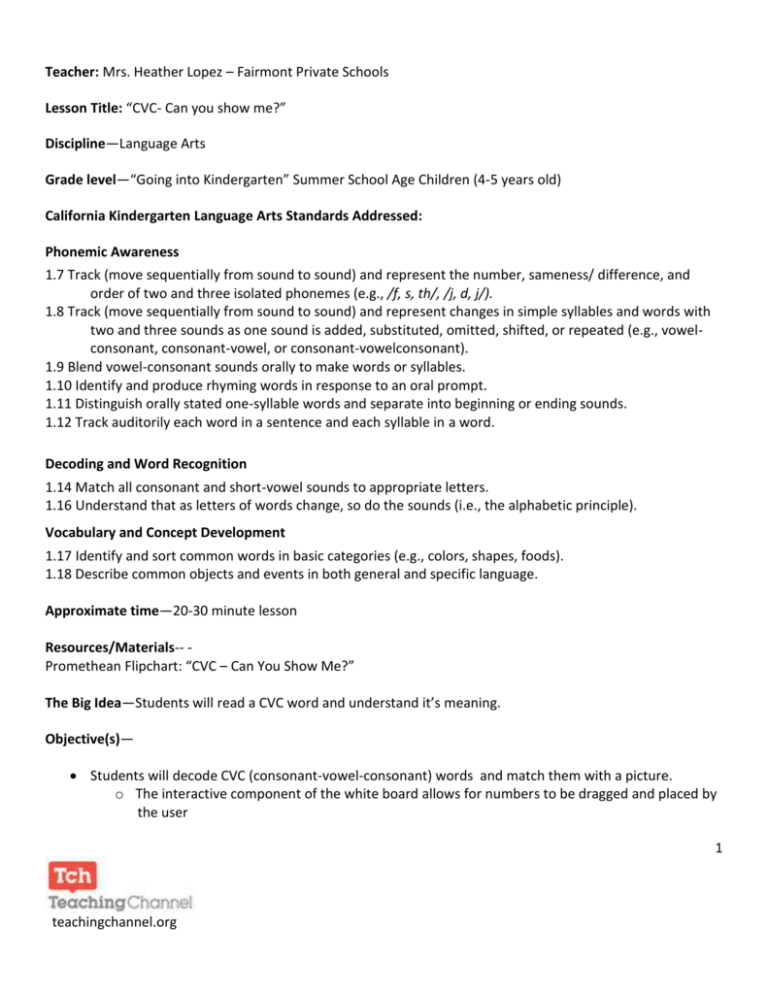
Teacher: Mrs. Heather Lopez – Fairmont Private Schools Lesson Title: “CVC- Can you show me?” Discipline—Language Arts Grade level—“Going into Kindergarten” Summer School Age Children (4-5 years old) California Kindergarten Language Arts Standards Addressed: Phonemic Awareness 1.7 Track (move sequentially from sound to sound) and represent the number, sameness/ difference, and order of two and three isolated phonemes (e.g., /f, s, th/, /j, d, j/). 1.8 Track (move sequentially from sound to sound) and represent changes in simple syllables and words with two and three sounds as one sound is added, substituted, omitted, shifted, or repeated (e.g., vowelconsonant, consonant-vowel, or consonant-vowelconsonant). 1.9 Blend vowel-consonant sounds orally to make words or syllables. 1.10 Identify and produce rhyming words in response to an oral prompt. 1.11 Distinguish orally stated one-syllable words and separate into beginning or ending sounds. 1.12 Track auditorily each word in a sentence and each syllable in a word. Decoding and Word Recognition 1.14 Match all consonant and short-vowel sounds to appropriate letters. 1.16 Understand that as letters of words change, so do the sounds (i.e., the alphabetic principle). Vocabulary and Concept Development 1.17 Identify and sort common words in basic categories (e.g., colors, shapes, foods). 1.18 Describe common objects and events in both general and specific language. Approximate time—20-30 minute lesson Resources/Materials-- Promethean Flipchart: “CVC – Can You Show Me?” The Big Idea—Students will read a CVC word and understand it’s meaning. Objective(s)— Students will decode CVC (consonant-vowel-consonant) words and match them with a picture. o The interactive component of the white board allows for numbers to be dragged and placed by the user 1 teachingchannel.org Students will act out their CVC (consonant-vowel-consonant) meaning with a physical action (sounds or body movement) Students will use a CVC (consonant-vowel-consonant) word in a sentence Students will rhyme CVC (consonant-vowel-consonant) words using consonant replacement activities Direct Instruction--teacher directed—Teacher will review the fact that letter order within a word is important in a lot of ways (words can change meanings by simply changing the letters around) At this time the teacher will demonstrate several ways we can change one word into many different words by simply changing a letter at a time. Guided Discovery--student discovery—students will participate in a lesson in which they will match CVC words to a picture, act out CVC word meanings and will use CVC words in a sentence. Small groups of students will be called up to actively participate with the interactive white board for each of these objectives. Vocabulary—consonant, vowel, vocabulary, and meaning Anticipatory Set Teacher will share flipchart to pose questions as to why letter order is important when making a word. Teacher will present vocabulary and “The Big Idea” of the lesson (see above) Procedures— Teacher will direct a lesson on CVC words Teacher & Students will be guided through the process and expectations together Students will independently solve flip chart questions without the assistance of the teacher Closure— Students will then be reminded of the lesson’s objectives (see above) and be told that they are now experts with numbers and can understand word meaning as they come across their own CVC words when independently reading. Assessment— Students will have the opportunity to act out, rhyme, or match a CVC word to a picture. Based on their ability to perform on the Promethean Flip Chart Activities, I can produce an informal assessment and note their ability to read and understand a CVC word’s vocabulary. Extension—Students will be able to do pencil-to-paper activities that require CVC word fluency, picture matching and consonant/vowel replacement techniques. 2 teachingchannel.org
